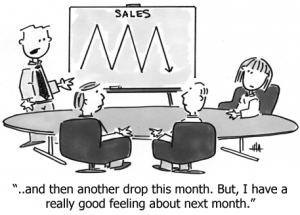I’ll admit, I didn’t go to the Harvard Business School. But I feel I could teach there after 25 years in the trenches of business. What kind of business am I talking about? Well, not the Fortune 1000.
Strangely enough, about 80% of all American businesses have no employees. According to recent data, the average business generates over $1 million in sales and has more than 4 employees. However, when these businesses with no employees are excluded, average sales per firm rises to over $5 million, and average number of employees per business exceeds 20.
 This 20% type of business is what I’m talking about.
This 20% type of business is what I’m talking about.
The leaders of these companies didn’t go visionary leadership school, and many I know never took business classes in college. Yet most work their tails off, take great risks, often using their personal resources to fund and grow their business.
What do the successful business leaders do that others don’t?
They plan. But even more importantly, they plan effectively—then adjust when necessary. Studies show companies that plan grow 30% faster than those that don’t. And those same firms grew faster and were more successful than those that didn’t plan. In fact, 70% of all fast-growing companies develop plans.
We see it, too. Clients who plan with us do much better than those who don’t.
So why don’t some businesses plan?
They’ve probably experienced poor planning: top down orders with little input from staff; dense, unreadable 3-ring binders of information; no assigned champions to actually do the work; and maybe the worst of all—planning that everyone forgets about once the plan is developed.
One new client told us they did planning every year, but nothing ever worked. They said their process was to come up with about 30 goals, and… I stopped them there. “No wonder your planning doesn’t work. Having 30 goals is way too much for a small business. Try three.”
Unfortunately, there are countless examples of poor planning. And truth be told, we used to create mega-huge plans (usually for bigger businesses). It was like we had to justify our work, fees, and cover ALL the bases.
News Flash: Big plans don’t work. Maybe for Fortune 1000 companies, but I highly doubt it.
Here are ten steps we found that work in business planning:
- Create a simple and focused process
- Come up with a big idea/theme that gets people excited
- Set a few meaningful and realistic goals, then strategies and tactics to achieve them
- Involve all staff (on some level)
- Assign the right champions to own specific tasks
- Develop short, memorable messaging (no more long paragraph vision statements!)
- Get commitment and follow-through by leadership
- Set tracking and measurement of goals
- Do ongoing communication and celebrate as goals are achieved
- Adjust the plan as needed throughout the year
Yet, effective planning is not just steps in a process. It’s about creating excitement and buy-in from leaders and staff alike. It’s about having clear roles and communicating progress. It’s about the hard stuff no one likes to do: being accountable—and holding others accountable, too.
Why not commit to some effective planning this year and become the growing and successful business you’ve always wanted?
“Never look back unless you are planning to go that way.”
– Henry David Thoreau
